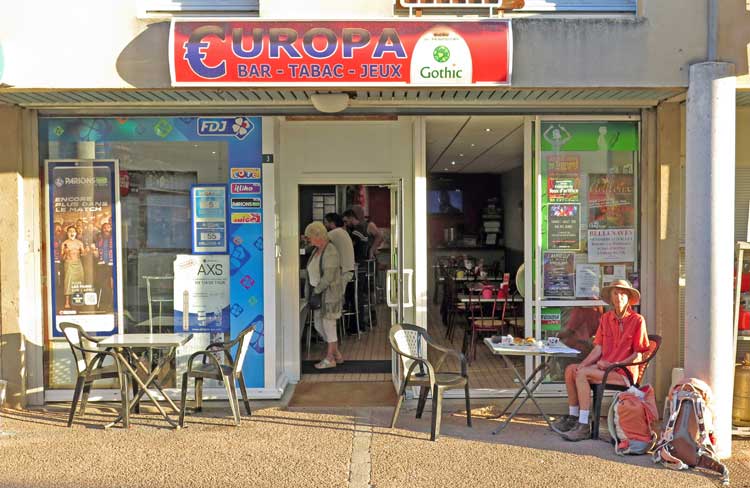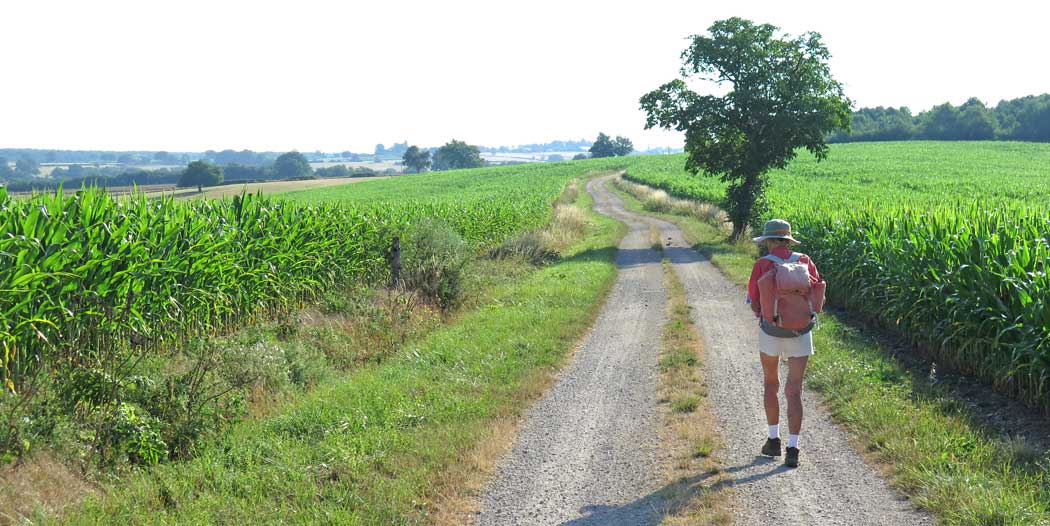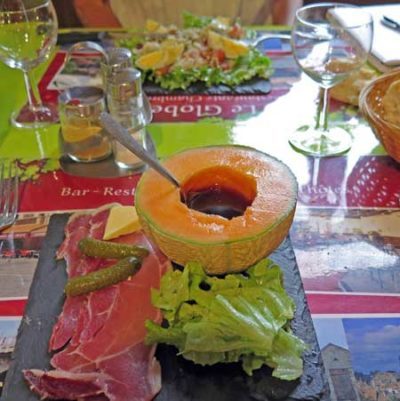
Wednesday, 4 July 2018
Distance 24 km
Duration 5 hours 5 minutes
Ascent 73 m, descent 85 m
Both the bar and the boulangerie opened at 7 am, so we stepped out of the hotel just before that, making sure to take all traces of our evening picnic with us.
This was to avoid offending our hostess, whose restaurant we had pretended to be too sick to visit last night.

Armed with two croissants, we went to the bar and sat in the weak early sunlight with our coffee, limiting ourselves to a single round because it was only about an hour and a half’s walk to the next big village, Chantelle.
We left Bellenaves along the D43, which turned off from the road to the camping ground, and as we turned I breathed a prayer of thanks that we had not spent the night in that dismal, desolate spot.
We soon left the tree-smothered village and entered a landscape of wheat, stretching to the horizon in every direction, tall and abundant enough to make an Australian farmer break down and cry.

The road was relentlessly straight except for a small curve where it rose to cross the A71 (the same autoroute that we had gone under the day before on our way to Ébreuil).
A little way past the autoroute, as the road continued on its unbending way, we turned off onto a wheel track that wandered through fields of green corn before joining another road for the last kilometre or so into Chantelle.


This was a substantial village, almost worthy of the name of town, with a fine main street leading to an abbey in a bend of the river Bouble, not that we got that far. We were more interested in the refreshments available.
A bar on the corner of the square was closed on Wednesdays, and at the boulangerie nearby we were told that there was no other, a shocking surprise.
Added to that, we realised that we only had a litre of water to get us the remaining seventeen or so kilometres to our destination.

But on wandering up through the main square, we found a small Vival supermarket and bought 1.5 litres of water for 29 cents, not a bad price to pay for the difference between life and death.

We also bought a slice of tarte, and at the edge of the village we sat down under a wayside cross and enjoyed a little picnic, with the help of the leftovers from last night.
I admired a handsome vegetable patch behind a neighbouring house, thinking of my own poor frozen garden at home.

We set off again about 9:30 am, on another uncompromisingly straight little road – it was not the hilliest part of the country, although beautiful in an undramatic way, with cows ambling around on green velvet pastures interspersed with woods.
We passed an enigmatic ruined tower, then angled through the tiny village of Fourilles, and carried on, past the elegant gates of a château hidden behind trees, finally coming to the junction with the D219.

We turned left, and saw on the slope ahead a small, manicured vineyard and its turreted château, almost too picturesque to be real.
At the foot of the vines we took a wheel track through gently rising pastureland, and arrived at another road.
By this time we were getting tired and hot, so we sat down in the shade of a house, leaning our backs against an ivy-covered wall, and drank some of our remaining water.
A car drove out from the house and the woman stopped to ask anxiously whether we had a problem. We assured her that we were fine and she drove off with a friendly wave.
This was near the top of the rise, and from there we followed a series of little roads that gradually descended towards the river Sioule and the town that we were heading for.
Every time we came to a patch of shade, we stopped for a drink, as the heat was now oppressive.
With about a kilometre to go, already in the unprepossessing outskirts of St-Pourçain, we drank the last drops and put our heads down for the final push.

We had been to this town last year, but we had approached from the east and this time, coming in from the high ground to the south, it looked entirely different.
There was a whole other town at this height, probably the original one, centred round a metallic belltower that we had never noticed before.
However we did not explore it then, as we were in desperate need of a bar, so we took the steeply falling road down to the river, past the camping ground, and straight to the bar near the bridge.
It was about 1 pm and the place was full of people having lunch. We threw ourselves down at an outdoor table and ordered two glasses of cold beer to celebrate our arrival. It was a joyful moment.
The camping ground, on an island in the Sioule, was as we remembered it – the opposite of the sad, lonely place at Bellenaves. Almost every plot was occupied by a campervan or a tent, and people were strolling about or basking in deckchairs.
The responsable warned us that rain was on the way, so we put up our tent before having showers, and went inside for our siesta, which was a good move, as it did rain a bit.
We talked about our plan for the way ahead, and realised that we had both been having doubts about it.
The difficulty was that the small village where we intended to stay in two days’ time, Noyant d’Allier, had no accommodation at all except for an aire de camping car – that is to say a strip of bitumen with no ablutions block, on which vans were allowed to stay for the night, but not tents.
We had in the past spent a couple of nights in these places, but only in circumstances of dire necessity. In the comfort of home we had decided that we could do it, but now that the day was approaching, the idea was becoming less appealing, and on top of that we were not sure that we would get a meal there.
By the time we emerged, we had dreamed up a new plan – instead of Noyant d’Allier, we would go to Moulins, a big, lively town, and stay in a hotel. That meant that we would need to buy a map, as our home-made ones did not extend to Moulins, so we set off to find a presse.
By this time it was cloudy and surprisingly cold after such a hot day. I went back to collect my warm jacket, only to discover that it was not in my pack – I must have left it on the back of a chair in some restaurant recently. The only protective garment that I had was my thin plastic rain cape, so I took that.

As soon as we turned into the beautiful tree-lined double avenue of the town it began to rain hard, causing us to rush to the nearest bar for shelter, and forget about finding a presse. Keith ordered a glass of rosé but I had coffee, as I was shivering with cold.
In the end I wrapped my raincape inelegantly around my shoulders. When the rain stopped, we looked at a few menus, which were not much to our liking, and eventually stepped over the road to the Hotel le Globe, where we had eaten with great enjoyment last year.

The menu here was four courses for €16. The dining room was warm and cosy, the décor was old-fashioned and all the other diners seemed to be hotel guests.
For entrées, Keith had half a wine-filled melon with raw ham, butter and gherkins, while I had a so-called salade fraicheur, which I chose because of the hard-boiled eggs on top.

Pressing on, Keith had roast veal and potatoes with gravy, and I had a faux filet with various vegetables and salad. Both dishes were lovely and we ate a lot of bread with them.
The third course was a plate of cheeses, and our hostess named them – chèvre, Bleu d’Auvergne, Cantal, St-Nectaire and Brie.

We worked our way systematically around the circle, although we were no longer as hungry as we had been.
To finish we both had Café Liegeois, a wonderfully decadent tower of cream, ice-cream and coffee syrup.
Before we left, we asked our hostess about where to buy a map and she told us that there was a newsagent just along the street.
As we walked home I was worried about my missing blue jacket until I suddenly remembered that I also had a long-sleeved white top.
This year, for the first time, I had brought two long-sleeved garments to France, because I thought that my blue one was getting rather thin. So that was a cheering thought.
Previous day: Gannat to Bellenaves


